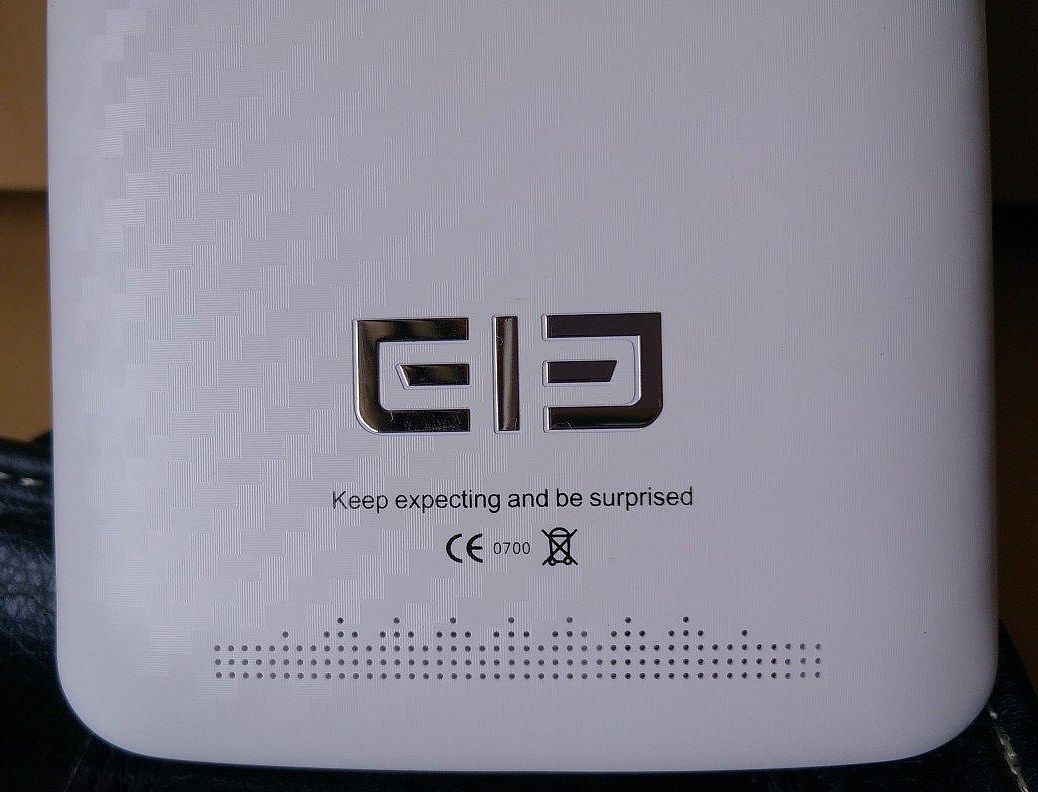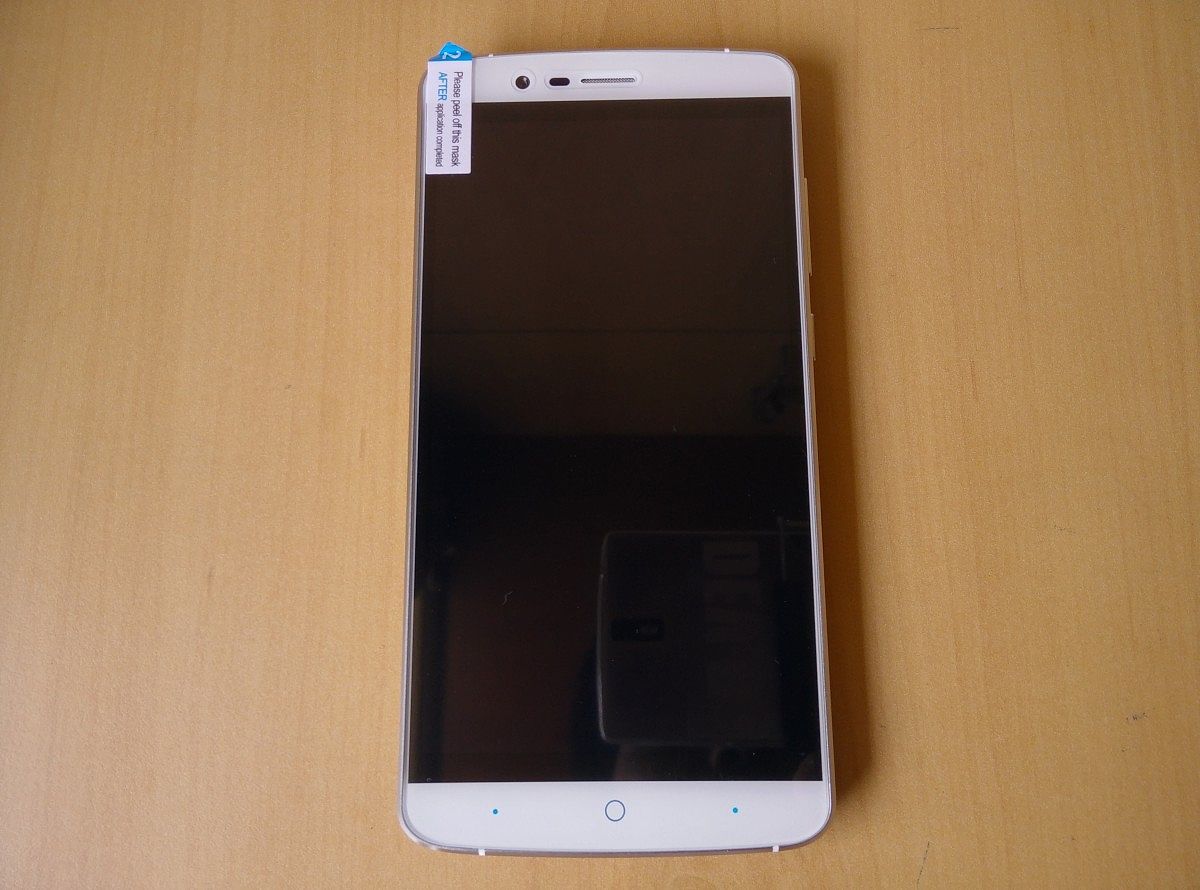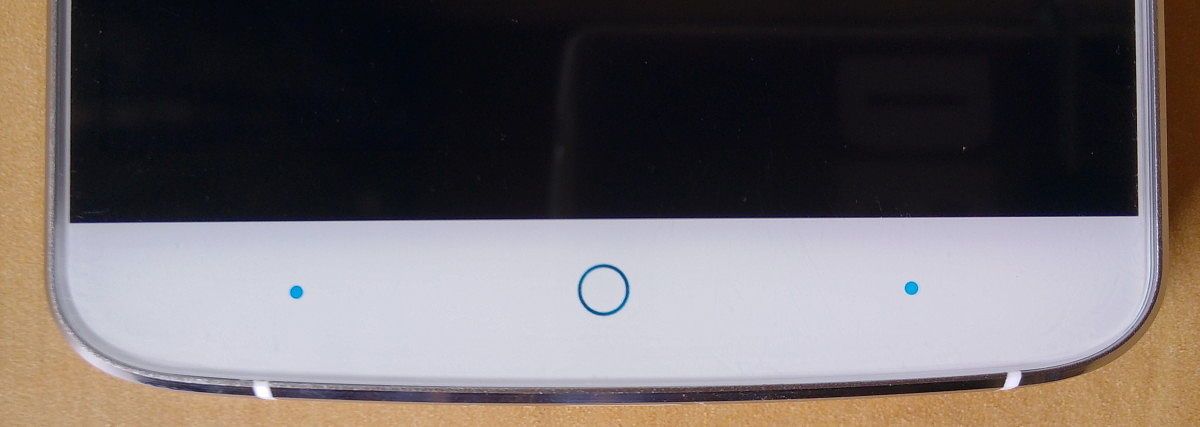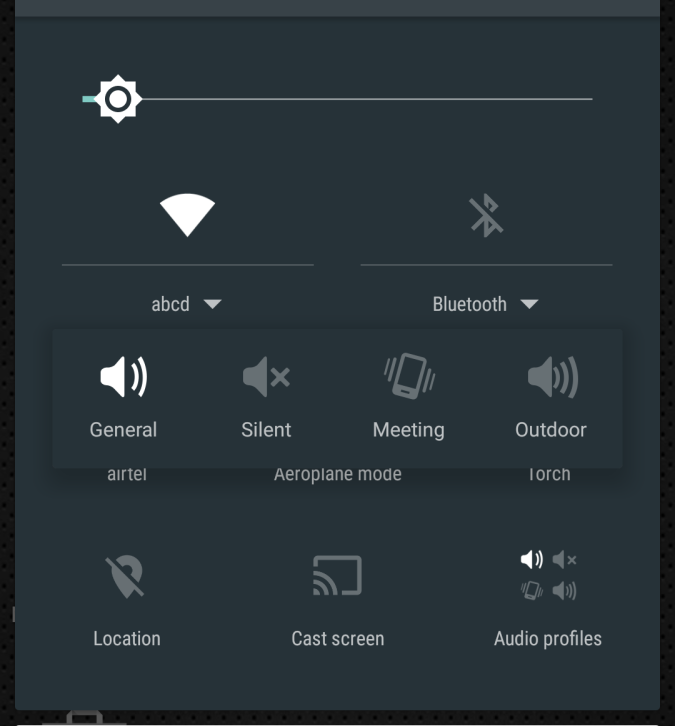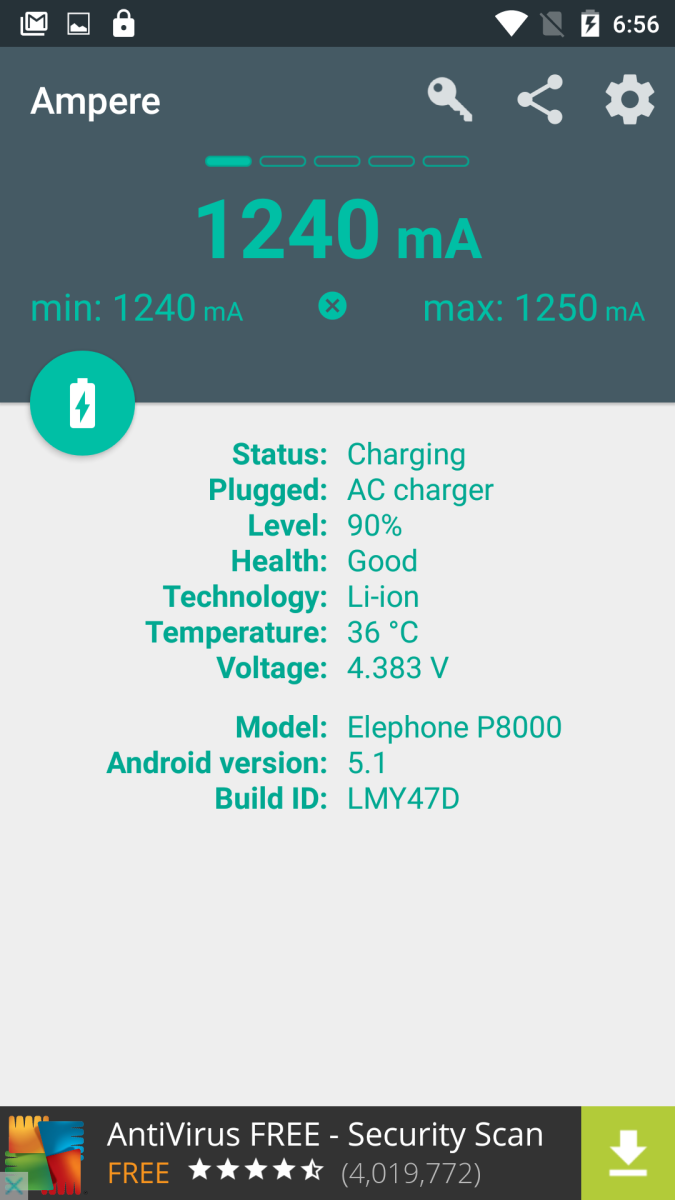The Elephone P8000 is a phone that attempts to defy the market trends by showing that one does not need to cut down the thickness of the phone to deliver a premium feeling device. Featuring a massive 4,165 mAh battery and a surprisingly good TouchID fingerprint scanner, the phone also packs in the specs that make for a decent mid-tier smartphone with a rather entry-level price, making it a choice that users can definitely consider for their next smartphone experience.
But does it provide that experience?
First, let's have a quick look at the spec sheet for the device:
|
Dimensions |
155.2 x 77.6 x 9.2 mm |
Screen Size |
5.5" |
|
Weight |
203 g |
Screen Type & Resolution |
TFT LCD, 1080 x 1920, 400 ppi |
|
Primary Camera |
13 MP, Samsung S5K3L2 Sensor, f/2.0 |
Secondary Camera |
5 MP |
|
Chipset |
64-bit MediaTek MT6753 |
CPU & GPU |
1.3 GHz ARM Cortex A53, x8;Mali-T720 |
|
Storage |
16GB Internal; expandable upto 128GB |
RAM |
3GB |
|
Battery |
4,165 mAh |
NFC |
No |
|
Fingerprint Sensor |
TouchID |
Supported Bands |
2G: 850/900/1800 MHz3G: 900/2100 MHz4G LTE: 800/1800/2600 MHz |
|
Android Version |
Android 5.1 Lollipop |
SIM |
Dual, Micro SIM |
Contents:
- Design, Build Quality
- Software UI & Features
- Performance & Memory
- Display
- Audio
- Camera
- Fingerprint Sensor
- Battery Life & Charging
- Rootability & Future Proofing
- Final Thoughts
Design, Build Quality
The Elephone P8000 can be easily mistaken for a high-end flagship, thanks to its rather impressive build quality. The phone features a metallic side frame with a smooth and polished metal texture. The back of the device is plastic, with a carbon fiber-like finish. These, along with the well-rounded corners on the device, give it a very decent grip and hold in the hand. The heavy weight of the phone (203g) feels disconcerting at first, especially if you are coming from much lighter yet similarly sized devices like the OnePlus One (162g). But the metallic build and the confidence it inspires when held in the hand, makes you quickly accustomed to the weight of the P8000, to the point that other devices start feeling unnecessarily fragile.
The retail box that we received came with two screen protectors (one applied very nicely onto the device, which I did not feel like removing from the phone as the Elephone P8000 does not come with a Gorilla Glass screen installation). Included along was a hefty power adapter and a standard micro USB cable, along with a small guide on using the phone.
On the device, the earphone jack finds place in the top right, while the volume rocker and the power button find place at the right side, giving you better accessibility on a device which is into phablet territory. On the bottom of the device, there is a single microphone hole and micro usb slot for charging and data transfer. The micro usb slot is oh-so-slightly off-centered, a minor cosmetic annoyance that I simply could not unsee after I noticed it while taking hands on pictures. It does not affect usage in any way though, as the USB 2.0 port works as intended.
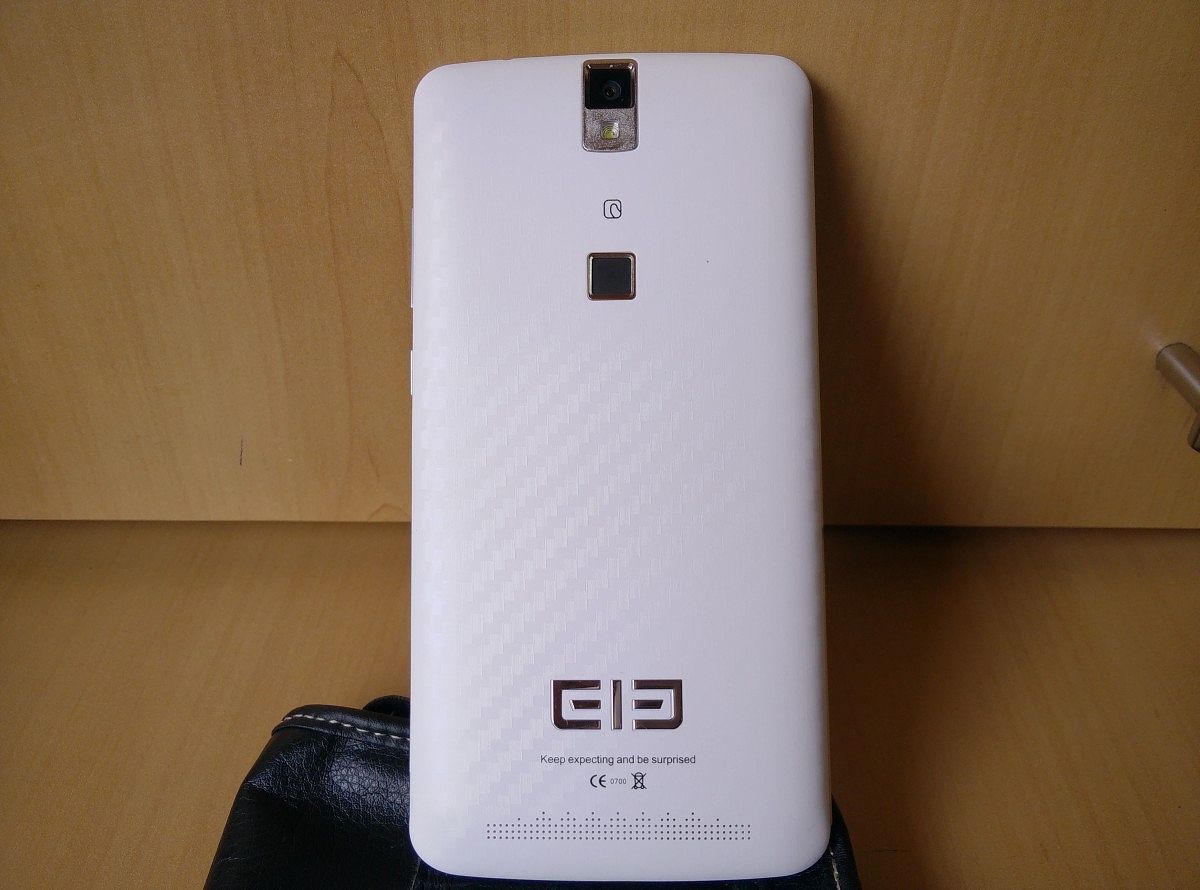 On the back of the device, you’ll find the 13 MP camera flushed rather deeply (0.2mm) in its spot, along with a single LED flash. This one of the few phones of 2015 that do not have a protruding camera, so you can confidently place the phone on its back without worrying about accidentally scratching the camera lens. Below the camera module is the Touch ID fingerprint sensor. On the bottom, you’ll find the Elephone logo and the company’s tagline “Keep expecting and be surprised”. The speaker holes make for the bottom of the device, albeit the speaker is present on the right edge of the device only.
On the back of the device, you’ll find the 13 MP camera flushed rather deeply (0.2mm) in its spot, along with a single LED flash. This one of the few phones of 2015 that do not have a protruding camera, so you can confidently place the phone on its back without worrying about accidentally scratching the camera lens. Below the camera module is the Touch ID fingerprint sensor. On the bottom, you’ll find the Elephone logo and the company’s tagline “Keep expecting and be surprised”. The speaker holes make for the bottom of the device, albeit the speaker is present on the right edge of the device only.
Taking the back cover off, you will be greeted with a non removable battery and 3 slots: one for a micro sd card, while the other two are for micro SIM cards. The Elephone P8000 supports dual SIM standby and also supports 4G, but no concrete information could be found on whether it does support dual 4G with dual standby.
The screen portion of the review has been purposely left for the end of the design section as this is where the device bears a few of its flaws. At first glance, it would appear as if the front of the device is majorly bezel-less. But once the display is on, it becomes apparent that the device did indeed skimp on slimming down of the bezels. The black bars surrounding the display become very obnoxious the more you use the phone. They become all the more apparent on the white color variant, and when all the glory of material design and white backgrounds come into play. They also act as a hindrance on the usage of the phone buttons, as these are centered on the bottom white chin (which is 1.1 cm in length), while the black bezel extends to another 0.5 cm above the chin. If you are used to on-screen navigation buttons, this will be a jarring experience initially as you will repeatedly aim for the center point of the total bezel, but end up falling short of it.
As far as buttons go, the Elephone P8000 comes with capacitive buttons below the black bar. The color is just a highlight and does not light up. The center home button is supposed to light up, as their own product page says. However, the one on our review unit does not work, and other owners in the forum also share the same plight. The other two buttons are merely represented by dots, and it is on the user to guess which of these acts as the back button and which is the menu button (Hint: It does not work as you’d expect in Android normally). This brings us on to the one major flaw of the device: it simply is not new-user friendly.
This theme resonates throughout the software implementation of the device, right from first booting it up to actually using it. Even as someone who has personally been with Android for 4 years, I still found myself wondering how some things are supposed to work on this device. Lots of things are either unintuitive or are tucked away under obscure options. The device definitely has a slight learning curve even if you are used to how Android generically behaves.
Software UI & Features
As I first booted up the device, I was greeted with the Elephone logo bootanimation. After this, I landed on the homescreen. Wait, what?
The first boot of the device directly lands you on the homescreen. There is simply no setup wizard to prompt you to choose the device language, connect to wi-fi, add a Google account, restore apps and so forth. What you get instead is a direct dump, face-first into a modified launcher which is quite different from the AOSP launcher. If I first boot the device without a SIM card, my system language is set to English, while if I first boot the device with a SIM card, the system language is set to Hindi. Even if this was seen as a targeted marketing action towards the Indian population, fact is, only about 40% of Indians speak Hindi. Not allowing the user to choose a language upon first boot feels like a glaring oversight, something that definitely impacts how a new user can navigate around in an unknown environment.
Adding a Google account involves going through the launcher to the settings menu. The setup has options to backup your data from the device to Google, but offered no solution to restoring them on to the phone itself even though our unit shipped with Google Play Store pre-installed. As the phone also lacks NFC, restoring apps from another NFC phone by tapping was also not an option.
Launcher
The Elephone launcher follows along closely to the iPhone launcher, wherein the app launcher is the homescreen. The bottom dock holds up to four icons, and is omnipresent throughout swiping the other homescreens. Apps are arranged in the order of newest-installed-last, and you can choose to create separate panes through arbitrary rearrangement as per your choice. The launcher also has an annoying habit of repeatedly grouping icons into folders based on Elephone-defined categories. This persists even after you remove the category and folder itself, as any new app would force-create the category it was supposed to belong in. Swiping up from the category folder will bring along a dock of “Nearby Applications”, a small collection of apps recommended by the launcher/Elephone. Swiping down will bring a "search engine" like menu, allowing you to quickly find apps by typing it out.
A curious addition to the launcher was a one-click RAM booster/ Task Killer widget, which displays a cute animation letting you know that your phone is “Faster than lightning now”, while it presumably clears the 3GB of RAM on the device of any app processes that were stored. Throughout my one week's usage, the device has no issues with handling RAM, so the presence of this widget is unsettling.
A redeeming factor with the launcher is that it comes with icon pack support. This support is not universal in nature, as it did not recognize a free theme I downloaded off the Play Store (I did not expect it to, to be honest). Thankfully, a Nexus theme was available from the built-on online store, making the launcher a bit more aesthetically bearable.
In my humble opinion, the launcher is very confusing. It attempts to emulate the iPhone-esque feel, but fails at delivering the same experience. Finding apps to launch can take long if you don't know where they are, and the quick search fails if you use auto-complete from your keyboard, half defeating the purpose. Apart from review purposes, I did not use this launcher at all during my 2 week period of use.
UI Additions
The UI on the Elephone P8000, apart from the launcher, follows along stock Android and does a few additions here and there.
The notification area has been left untouched for the most part. It does tend to bug out though, as often when you swipe down, the shade just lowers a little and stays static for a while till you next touch the display. Sometimes, the "clear notification" 3-bar icon that we are so used to seeing also disappears. Both of these are random bugs and difficult to forcefully reproduce.
The Quick Settings panel sees a very useful addition in the form of an audio profile toggle. The toggle lets you switch between General, Silent, Meeting and Outdoor; of which only General is a customizable profile which can be edited through your general phone ringer settings. The P8000 runs on Android 5.1 Lollipop, and this extra bit of functionality was really thoughtful and appreciated.
The Elephone P8000 also comes with a dedicated Recents app. Why, you ask? It is because the phone's buttons do not follow along the conventional Android styling of Back-Home-Recent. Instead, the phone's capacitive buttons are reminiscent of Samsung's implementation during the Gingerbread era: Menu-Home-Back. As a new user, you would have had to do a bit of trial and error to figure out the key mapping as the buttons themselves are merely represented by dots, as mentioned in the design section above. Also surprisingly, long pressing the home button brings up the conventional recents panel, which really leaves you wondering on why would the phone need a dedicated recents app taking up one launcher icon and some precious memory when the baked-in Android functionality works just as well.
Here's a list of other feature additions that I found out while digging through the various settings menu:
- Auto-start Manager: Control apps that can start automatically upon boot.
- Permission Manager: Control various permissions of apps. Not at the same detail level as something like XPrivacy, but a rather workable implementation for beginners. The feature did have an annoyingly persistent notification irrespective of whether you have this feature enabled or not.
- Data Protection feature: Lets you lock individual files on you phone using a pattern lock, even when the phone has a fingerprint sensor.
- Mobile Anti-Theft setting: Prevents wiping of the phone and allows remote lock. This setting uses a 6-12 digit PIN, instead of the fingerprint sensor.
- SIM Manager: Set preferred SIM for data, calls and SMS.
- Separate Data Counter: Displays data usage for different SIM's and for WiFi.
- MiraVision setting: Screen Calibrator with two built-in profiles (Standard and Vivid), along with a manual mode.
- Sound Enhancement: Boosts volume output.
- Intelligent Power Saving Standby: Not a clue what this does (apart from the buzzwords in the name) as it is simply a toggle. This is in addition to the AOSP power saver mode that kicks in when device reaches 15% battery.
- On/Off Scheduler: Shut down and boot the device on user defined timings.
- Backup App: Backup apps and data (not app data) to microSD card.
Most of these additions would otherwise necessitate the use of a custom rROM or Xposed. Having them baked in offers a lot of convenience and extra functionality. However, most of these are hidden within the settings. If a user was not actively looking for these or other features, there is a good chance that they would never know these existed. Even then, some of the implementations don't make sense. For example, the Data protection feature uses a pattern lock, while the anti-theft setting uses a 6 digit PIN, while the phone itself has a very reliable and quick fingerprint scanner.
Performance & Memory
The Elephone P8000 features a Mediatek MT6753 processor. This octa-core processor is 64-bit, with all the eight cores clocked at 1.3 GHz. For the GPU, the P8000 features a Mali T720, which has eight processing cores clocked at 650 MHz and performing at 82 giga-FLOPS. The chipset was put in this phone for mainstream, consumer and budget oriented decisions, and this fact is reflected by the benchmarks. Looking at pure numbers, the Elephone P8000 sits very firmly in the entry-level category as the benchmarks are nothing to write home about.
Just from looking at benchmarks scores, one can verify that this device is no flagship killer in terms of peak performance, but this was expected: as previously stated, it is a budget-oriented phone with an accordingly compromised SoC. The chipset, however, does have some competition in its own middle-range category. Devices like the Moto G and Moto X Play boast the Snapdragon 410 and the Snapdragon 615, both very capable chipsets.
The Mediatek MT6753 outperforms the Snapdragon 410 in the Moto G (3rd Generation) in theoretical performance, with superior single-core and multi-core scores in Geekbench, and AnTuTu scores are higher overall (even when factoring less RAM and slower storage in the Moto G), with the breakdown suggesting that the Snapdragon 410 is better only in graphic tests. The GPU tests confirm this, as the Snapdragon 410’s Adreno 306 GPU scores higher on GFXBench’s Manhattan and similarly on T-Rex. The GPU of the Snapdragon 615 more than triples the scores the Elephone generates, and it also closely matches the scores provided by the Elephone in CPU tests like Geekbench 3.
The redeeming factor for the device is that it there is no evidence of thermal throttling. The device heats up marginally near the camera module when you try to push it repeatedly, but the results of benchmarks under these conditions continue to conform to the average and are not skewed unfavorably.
Gaming on this device once more validates the graphic tests’ output. The frames-per-second results obtained in most of the games we tested (highest settings) are mediocre, usually hovering at around half of what a high-end flagship outputs. Simpler games like Clash of Clans can be played efficiently, but the more complex and better-looking 3D games show the chipset’s inadequacies. That being said, if you are not intending to game a lot on the device, you shouldn’t have much of a problem, and you can always tone down the graphics settings if need be as the games are still playable, the missing frames just get more noticeable on tasking games.
For storage, Androbench storage tests (4KB) show that the Elephone storage is appropriate for the price it commands. As mentioned above, it outperforms the solution found in the Moto G 3rd Generation (99MB/s sequential read, 44.5MB/s sequential write, 19.5MB/s random read, 18.5MB/s random write). The Elephone P8000 also comes with 3GB of RAM, which ventures towards the "overkill" end of the spectrum (for a budget phone) but is good for future-proofing the device. RAM usage on the device always remains under bearable limits and is not overtly aggressive as seen on some recent flagships. Apps stay in memory for long periods, and loading times are quick because of this.
It is evident that the device is not even into the mid-end category when looked purely from a theoretical point of view. It continues to be at par with yesteryear's flagships, but coming nowhere close to the more known flagships of 2015. But, with the $170 price tag that this device commands, one can rightly assume that it wasn't meant to compete for the top spot in the first place.
Real world usage of the phone is a different ball game from the spec sheet. Per my experience, this is amongst one of the few phones in the low-end price segment that can continue to remain snappy even after installing 50+ apps. Much of this credit goes to the overkill RAM, but the MT6753 chugs along happily under day-to-day tasks. Overheating and dropped rates are problems not faced till you start heavy gaming on the device. For most users, the Elephone P8000 would fit like a glove when it comes to regular smartphone functions.
Display
The Elephone P8000 comes with a 5.5" IPS LCD display with a resolution of 1080 x 1920, giving the device a pixel density of 401 ppi. The display gets really bright at maximum levels, lending itself some great outdoor viewing capabilities. However, the minimum brightness of the device is not very low, which would necessitate the use of a dark screen overlay for night-time usage.
Further, the device features a rather neutral display with decent color reproduction, except for reds, which are rendered quite dull. The black levels on the device are at par with what you would expect from a typical LCD panel, albeit these do leave a lot to be desired when they are adjacent to the “true black” bezel bars of the phone, or when compared to AMOLED panels for that matter (which you normally won't find in this price range). Viewing angles of the phone are surprisingly good, and color distortions happen only when viewed from extreme angles.
The phone also features display calibration in the form of MiraVision settings. The standard display profile is neutral and accurate, with the “Vivid” profile significantly increasing the saturation levels. There is another mode for manual user adjustment, whereby you can adjust various parameters to better suit your liking. Personally, coming from a rather warm and “yellow tinted” OnePlus One, this feature was very useful to get me adapted and make the transition from the OnePlus One to the Elephone P8000 and back to OnePlus One less visually jarring.
Maximum Brightness:
Minimum Brightness:
Audio
The speakers on the Elephone P8000 are as typical as you would expect from an entry-level device. The back facing speakers are only suited for casual single person media playback, as the loudness is mediocre at best. When you enable “Volume Boost” settings found under the Sound settings, the loudness increases at the cost of clarity. Sounds start cracking, and noise and distortion creep in, making the trade-off between volume to clarity unfavorably disproportionate.
Audio via the earphones was satisfying and adequately loud per my experience. Sound quality and richness is at par with other smartphones, and is arguably better than what one could expect from a Chinese low-end device. The device, however, will not do justice to any high-end personal audio equipment.
The Elephone P8000 features only a single microphone hole, and as a result loses out on active noise cancellation which people have assumed as standard on Android devices. Calls made from the device are good in quiet environments, but as expected, take a hit in crowded and noisy areas. I’ve had my share of callers asking me to repeat as they could not make out the spoken words properly, something that was very rare while I used the OnePlus One (or the HTC Desire S for that matter).
On the flip side, the front earpiece of the device offered decent volume and quality, and is adequate for all calling needs.
Camera
The Elephone P8000 uses a Samsung S5K3L2 13MP sensor, instead of the traditional Sony sensors that most of the industry powerhouse use. The sensor does quite well under good lighting conditions for the price point of the device, but fails miserably in low light performance, as most phones in this price segment tend to do. Dynamic range as well as exposure performance on the sensor is abysmally poor, as the phone had a hard time recognizing objects which were under low light. Focusing under good lighting conditions was average, while under low lighting conditions, it was absent.
All in all, the camera performance of the phone is what you'd typically expect from the entry-level smartphone.
Fingerprint Sensor
The Elephone P8000 comes with a TouchID fingerprint sensor which supports 360 degree identification. The sensor on the Elephone P8000 works very well and on par with what you'd expect from flagships that come with such a sensor. The phone can store a maximum of 5 fingerprints (and a bug in the menu would let you rename only the first of these), and the phone maintains the fast speed of recognition irrespective of the number of the prints stored.
The sensor is a bit on the sensitive side, and requires your fingers to be perfectly still for that one second it needs. The slightest movement that may mimic a sliding motion would cause recognition to fail. The first few days with this phone, this was a very common occurrence, with success rates being close to 3 out of 5 tries. Eventually, once you get used to the bulk and feel of the phone as well as the sensitivity of the sensor, success rates will go up as I could get a perfect success rate towards the end of my use period. The speed of recognition is also fast enough that a standard Android lockscreen would be seen as a chore when you can simply hold your phone naturally and have it unlocked.
Battery Life & Charging
The Elephone P8000’s battery is amongst its main selling points, and is a perfect example of how a phone should adapt its hardware to suit the needs of the user, rather than having a user adapt his needs based on the phone’s hardware. With a large 4165 mAh Li-Po battery, the device powers through a day’s worth of usage like a hot knife slicing through butter. My normal day-to-day usage, which involves a total of 6 IM apps, some productivity apps, along with entertainment through Youtube or bunch of raids on Clash of Clans and some voice calling gets easily powered through with the battery. I haven’t had the opportunity to reach 0% charge on this device yet on my ~2 weeks worth of daily usage, a feat that is really impressive considering the battery abuse I put my phone’s through.
Benchmarks back this impressive specification, as PCMark’s battery endurance testing gave the phone a whooping 10 hours and 20 minutes of uninterrupted work to plough through, in an effort to get the battery down from 100% to 20%. This test was done with minimum brightness (which as stated above, is not very low), and with airplane mode. Second round of PCMark battery endurance testing was done on maximum brightness with WiFi connected, and the phone still managed to score 6 hours of screen on time with repetitive CPU and GPU tasks. [Note: Abnormal spike in temperature in 2nd test was because of lack of proper ventilation as I was traveling .]
Keep in mind, that all of this usage was on Android 5.1. With Android M and all the battery oriented improvements that it brings along, IF the phone gets updated, we could see it improved upon much more. My app usage also borders around the “abnormal” mark, so with lighter usage, it would not be surprising if the phone lasted 2 days on medium usage or upto 4 days on light usage.
Further optimizing the battery through an efficient kernel and making use of apps like Greenify would further increase the scope of this phone.
As far as charging goes, the device does not feature Quick Charge 2.0 standard. The accompanying power adapter is rated for 5V/2A output, the same as my OnePlus One charger. To complicate matters, the Elephone stock charger is very bulky and worked exactly once for me. After the first charger usage, the charger would no longer work, forcing me to rely on my OnePlus One charger.
Charging times for the device are quick but not at the levels of Quick Charge 2.0. The phone is advertised as having a “Quick Charge” feature nonetheless, so we will assume it is based upon similar technology to the Quick Charge 1.0 standards. In practical scenario, a 30 min charge will juice you up from 30% to 50%, while it will take roughly 2 hours worth of charging to reach 100%. The phone also remains cool throughout the charging times.
Rootability & Future Proofing
Elephone devices have had a very good track record of allowing root and ease of development, and the P8000 follows along on its family lines. Our forums for the Elephone P8000 are not yet populated with first hand guides, but there are plenty available online. A very surprising occurrence with this phone is that some users are reporting that rooting this device only involves just downloading SuperSU from the play store, which implies that the phone came with some installation of superuser binaries present. This is what happened to our review unit.
Depending on your point-of-view, this could be a good thing, or a very bad thing. Good as in, rooting this device is extremely easy and requires all of 2 minutes and no data wiping. The option "OEM Unlocking: Allow the bootloader to be unlocked" under developer options settings was unticked throughout my review period, implying that the phone was still bootloader locked and the phone was still rooted within minutes. If you are a privacy conscious person who is using a Chinese phone with a fingerprint scanner, you will find this aspect of the phone disturbing.
If the above root method does not succeed for you, you can follow along Elephone's method for rooting the phone. This will also install CWM onto your phone, and open the possibilities of installing custom ROMs with ease.
Elephone is also one of those rare Chinese manufacturers using MediaTek SoC's that release their kernel sources, which can be found here. The company is also looking to establish "long-term relationships" with developers who can create 3rd party ROMs for the device. Benefits include being sent a copy of the Android 5.1 source code for the P8000 and option to be a member of the Elephone dev team.
But will this phone receive Android 6.0 Marshmallow? We hope so, but there has not been any official confirmation from the Elephone team regarding the update.
Final Thoughts
Using the Elephone P8000 has been a very pleasurable experience for me. The phone goes overkill on its selling points, mainly the RAM, the battery, the fingerprint sensor and its premium build quality; all of which work as good as advertised. For the rest of the spec sheet, the phone compromises in an effort to keep the price of the phone very low. The end result is a phone that is modest in areas where it wasn't meant to excel and the top cream in areas it was meant to.
Some feature removals like the exclusion of NFC, Gorilla Glass, Wireless Charging or Quick Charging, Notification LED and global SIM support hurt the phone's chances of becoming an instant-buy. And looking at things from a warranty and replacement perspective, Elephone also does not have an extensive customer support network outside of China. On the other hand, it is difficult to find phones in this price range which have a manufacturer attempting to care for 3rd party developers. The large 4,165 mAh battery and an excellent fingerprint sensor are also very hard to turn away from.
The Elephone P8000 costs $169.9 from an authorized Elephone reseller website, sans shipping. This price does not include local taxes and customs, so that is one more hurdle in purchasing the phone. In India, the product listing made a brief appearance on Flipkart but has been out of stock for a while.
Should you buy the Elephone P8000? Concluding this review, I realize that the answer to this question is not very clear-cut as the phone has its fair share of flaws. If you are in the market on a tight budget and want a phone that can run all your tasks through a day or four, the answer is a resounding "Yes". If you are looking for a spec heavy device on a tight budget which can run the latest high-end games, you are in the wrong price segment. If you are looking for a phone for your technologically disabled relative, this will not be the premier choice as the phone needs a certain level of basic Android knowledge or an inclination to learn and discover in order to be properly utilized.
The Elephone P8000 is a phone with a lot of potential, looking for someone who can realize that. If you are on a budget, you will be pleasantly surprised at what this smartphone has to offer. Just don't expect it to be the flagship of your dreams, nor the one Elephone wishes it was.

